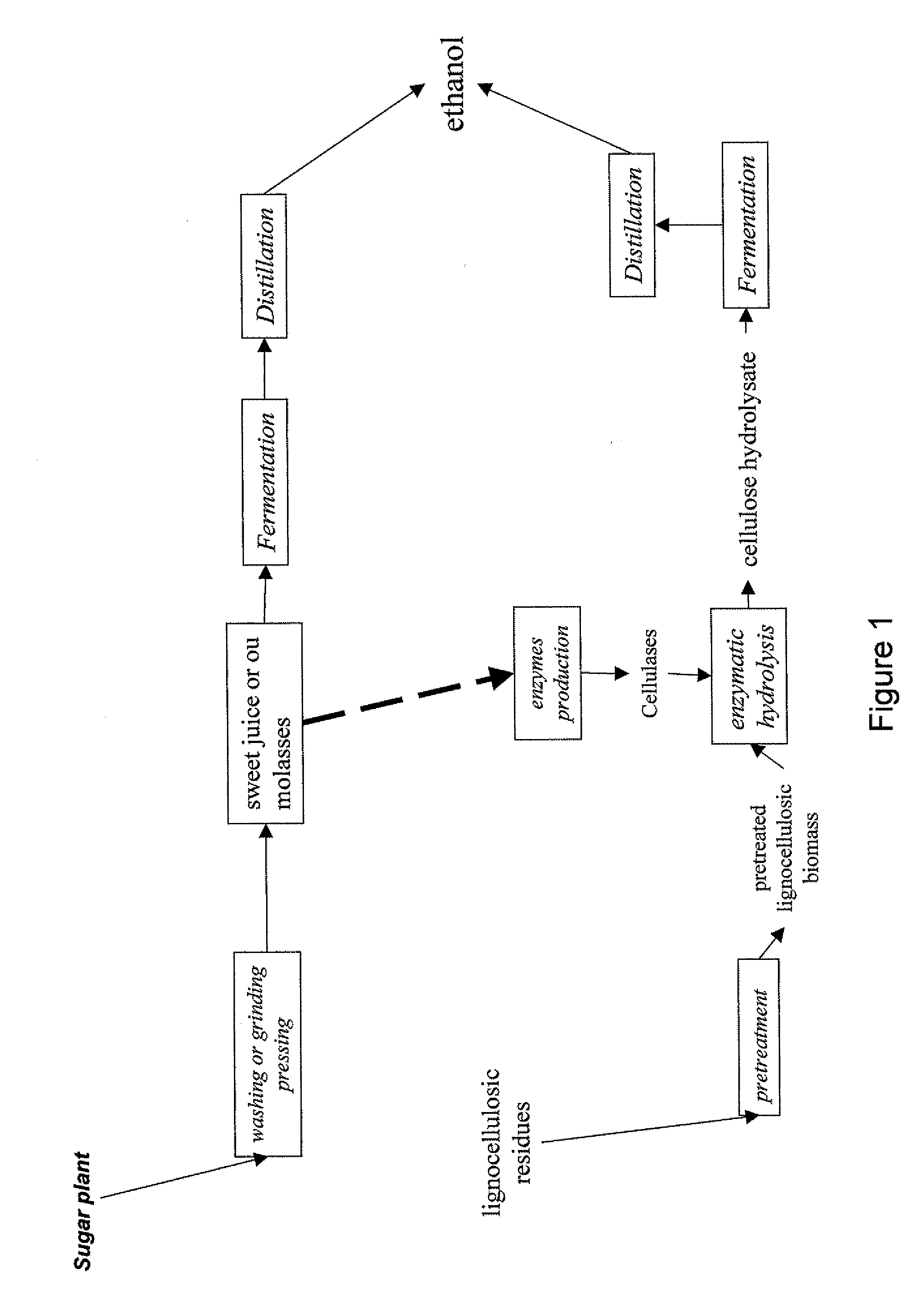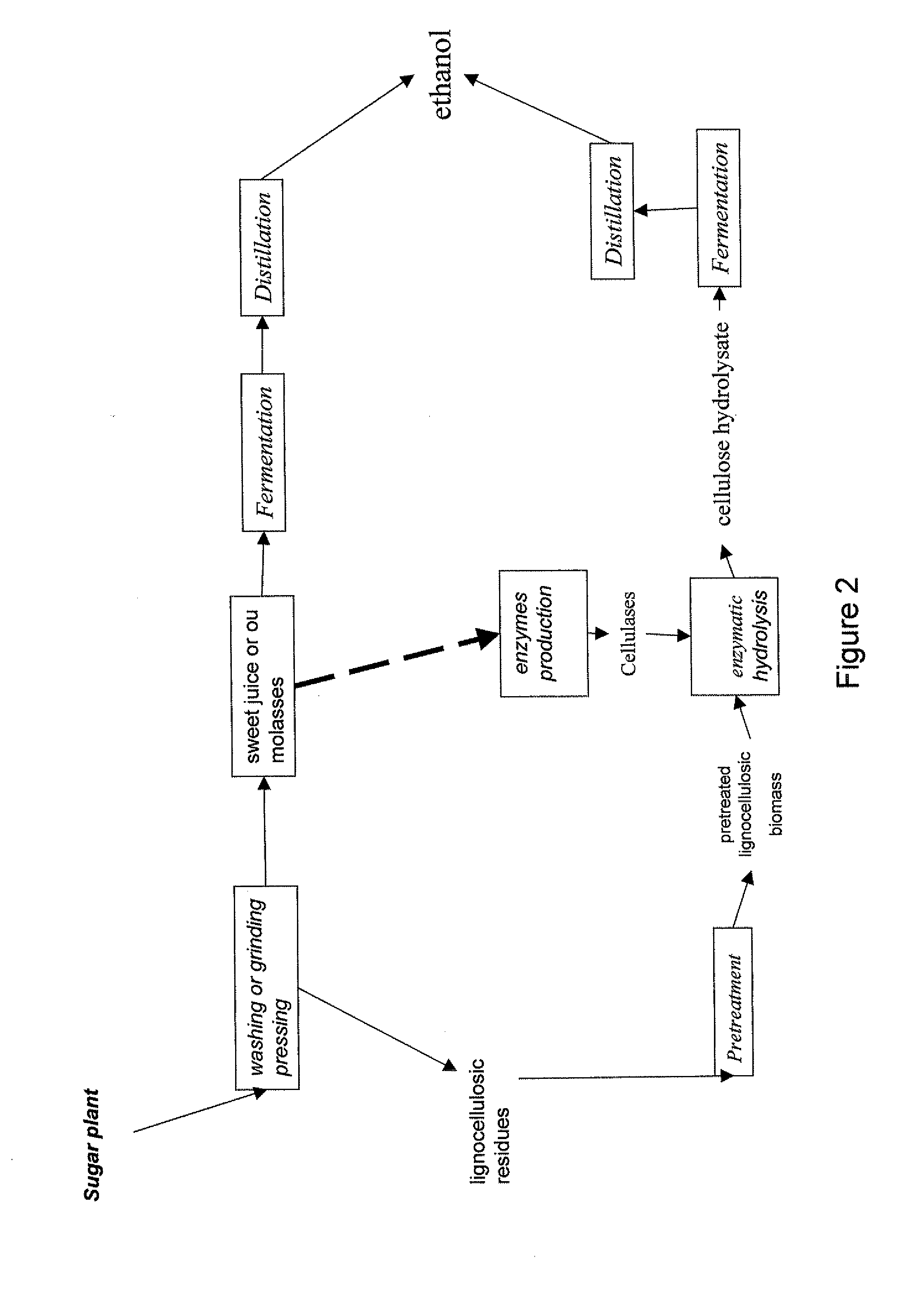Method of producing alcohol in the biorefinery context
a biorefinery and alcohol technology, applied in the direction of biofuels, biochemical equipment and processes, fermentation, etc., can solve the problems of difficult industrial use, high cost of enzymes, and inefficient conversion of hemicellulose pentoses to ethanol
- Summary
- Abstract
- Description
- Claims
- Application Information
AI Technical Summary
Problems solved by technology
Method used
Image
Examples
example 1
Production of Enzymes on Lactose
[0048]The production of cellulases was carried out in a mechanically stirred fermenter. The medium had the following composition: KOH 1.66 g.l−1, 85% H3PO4 2 ml.l−1, (NH4)2SO4 2.8 g.l−1, MgSO4, 7H2O 0.6 g.l−1, CaCL2 0.6 g.l−1, MnSO4 3.2 mg.l−1, ZnSO4, 7H2O 2.8 mg.l−1, CoCl2 4.0 mg.l−1, FeSO4, 7H2O 10 mg.l−1, Corn Steep 1.2 g.L−1, anti-foaming agent 0.5 ml.l−1.
[0049]The fermenter containing 1.75 l mineral medium and 70 g lactose was sterilized at 120° C., then seeded with 0.25 l of a liquid preculture of the CL847 Trichoderma reesei strain. The preculture medium, supplemented with 5 g.L−1 potassium phthalate to control the pH variations, was identical to that of the fermenter. The preculture fungus was grown on lactose, at a concentration of 30 g.l−1. The inoculum growth lasted for 2 to 3 days and was carried out between 27° C. and 30° C. on a shaker table.
[0050]After 46 hours growth, the initial substrate of the fermenter was exhausted and the 250 g.l...
example 2
Production of Enzymes on Saccharose
[0055]Enzyme production was carried out under the same conditions as in Example 1, but the lactose was replaced, in the batch stage, by saccharose and the fed-batch stage performed with a solution of 60% lactose and 40% saccharose. The strain used was a CL847-derived strain transformed with the A. niger invertase (Berges et al., 1993).
[0056]The fermenter containing 1.75 l mineral medium and 40 g pure saccharose was seeded with 0.25 l of a liquid preculture of the CL847 Trichoderma reesei strain. The preculture carbon-containing substrate was glucose at a concentration of 20 g.l−1. After 48 hours growth, after exhaustion of the initial substrate, the 200 g.l−1 solution of 60% lactose and 40% saccharose was continuously injected at a flow rate of 5 ml.h−1 up to 165 hours.
[0057]The analytical determinations of the final must gave the following results:
Substrate consumed g · l−171.9Biomass g · l−112.2Proteins mg · ml−132FPU U · ml−123Cellobiases U · ml...
PUM
| Property | Measurement | Unit |
|---|---|---|
| temperature | aaaaa | aaaaa |
| temperature | aaaaa | aaaaa |
| temperature | aaaaa | aaaaa |
Abstract
Description
Claims
Application Information
 Login to View More
Login to View More - R&D
- Intellectual Property
- Life Sciences
- Materials
- Tech Scout
- Unparalleled Data Quality
- Higher Quality Content
- 60% Fewer Hallucinations
Browse by: Latest US Patents, China's latest patents, Technical Efficacy Thesaurus, Application Domain, Technology Topic, Popular Technical Reports.
© 2025 PatSnap. All rights reserved.Legal|Privacy policy|Modern Slavery Act Transparency Statement|Sitemap|About US| Contact US: help@patsnap.com


